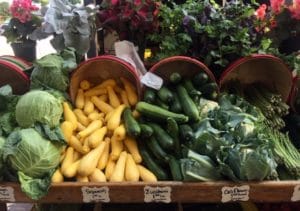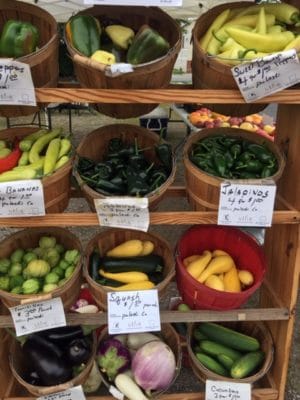
Growing up in the 1960s and 70s, farmers’ markets were unimaginable in Kentucky as “everyone” grew a garden. In fact, with the exception of an occasional orchard visit, we ate what we grew when it came to seasonal produce. Even though the return of the garden or a few tomato plants (or kale for me!) in the backyard has exploded this year due to our current COVID pandemic, farmers’ markets (or CSAs) in our respective towns and cities remain more than our source of “fresh.” Beyond the produce, food and wares, they are a reflection of resiliency and community spirit and symbolic of sustainability in action.
Defining the Market

CSAs (community supported agriculture) or on-farm markets may be extensions of a farmer’s market vendor but are defined as separate entities. CSAs, approximately 900 strong, are farms or a network/association of multiple farms that offer consumers regular (usually weekly) deliveries of locally-grown farm products during one or more harvest season(s) on a subscription or membership basis.3 On-farm markets must be managed by a single farm operator that sells agricultural and/or horticultural products directly to consumers from a location on their farm property or on property adjacent to that farm. There are approximately 1,600 on-farm markets in the United States.4
The Economic Factor
With the continual growth of farmers’ markets across the country, there is a growing body of research that points to the economic benefits of farm-direct marketing. A Sacramento, California, based study showed that, “for every dollar of sales, direct marketers are generating twice as much economic activity within the region, as compared to producers who are not involved in direct marketing.”5

In addition to direct cash sales, the acceptance of USDA-based programs like SNAP, WIC and Senior Program benefits by markets and farmers has increased significantly over the past eight years. Based on a 2017 USDA report, the amount of SNAP benefits redeemed at farmers’ markets increased nearly 35.2% from 2012 ($16.5 million) to 2017 ($22.4 million) — a benefit for the farmer and most of all, the recipients.7
Preservation of the Land and Our Trust
With the reality that the average age of the U.S. farmer continues to rise (now 59.4 years), farmers’ markets can serve as incubators for new enterprises and a venue for younger farmers to build diversity within an existing farming operation or transition to a new crop. For example, Gilles took the opportunity to expand his family’s cow-calf operation from an initial offering of “sides of beef” to a year-round consumer-facing supplier of locally grown meat and poultry. Suzanne Cecil White, a former teacher who has followed in the footsteps of her father — a pioneer in growing consumer-based crops in Owensboro — has developed a year-round supply chain of seasonal produce and plants. These are two of the hundreds of examples from across the country that reflect the innovation and commitment to preserve farmland for future generations.

Resiliency
With the disruption of the food distribution system over the past few months due to COVID-19, local farmers’ markets, CSAs and on-farm markets have seen a surge of local customers’ support, bringing a positive impact to their respective communities. But, like any entity, opening of seasonal farmers’ markets didn’t come without adjustments. Permanent pavilion structures stand empty, yielding to free-standing vendor tents in parking lots with single entry and exit. Implementation of state or local mask requirements with six-feet distance markings are evident throughout most markets. Cashless transactions, produce pre-orders, no-touch buying and often, long lines have become the accepted norm rather than frustration whether buying in Kentucky, Colorado or wherever one may shop.
Resiliency, like sustainability, is the core existence of any farmer or farming operation, and this year has been a challenge. As consumers, we have experienced disruptions as well, adapting to virtual communications and limited social interactions. But there is one constant that remains: the access to locally grown seasonal food thanks to the commitment of our farmers and producers. Take the time to support farmers’ markets in your community or whatever community you visit. We all share in the success when our food systems succeed. To find a farmers’ market, CSA or on-farm store, check out the links listed below.
References
1. National Farmers Market Week, Farmers Market Coalition.
2. Local Food Directories: Farmers Market Directory, U.S. Department of Agriculture, Agriculture Marketing Services.
3. Local Food Directories: Community Supported Agriculture (CSA) Directory, U.S. Department of Agriculture, Agriculture Marketing Services.
4. Local Food Directories: On-Farm Directory, U.S. Department of Agriculture, Agriculture Marketing Services.
5. “Economic Impact of Local Food Producers in the Sacramento Region,” University of California Agricultural and Natural Resources and UC Davis, Spring 2016.
6. “Entrepreneurial outcomes and enterprise size in US retail farmers’ markets,” American Journal of Alternative Agriculture, by Gail W. Feenstra, Christopher C. Lewis, C. Clare Hinrichs, Gilbert W. Gillespie and Duncan Hilchey, Volume 18, Issue 1, March 2003.
7. Supplemental Nutrition Assistance Program (SNAP), Farmers Market Coalition
8. Will the “New Normal” Become Normal in Our Quest for Food?, The AgriNutrition Edge Report, by Marianne Smith Edge, May 14, 2020.
